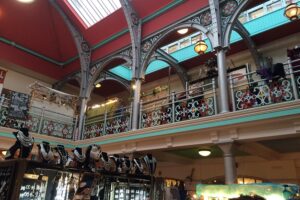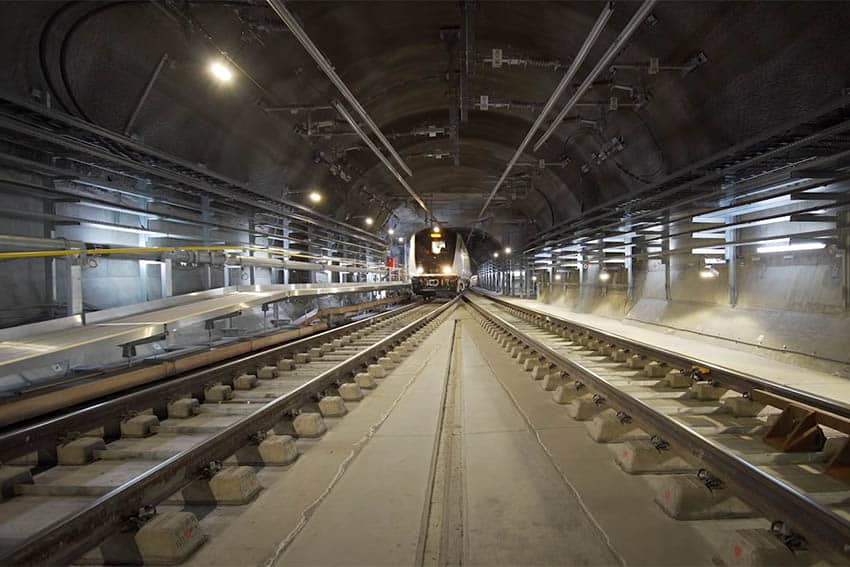The Edgy East End of London
By Gaby Koppel
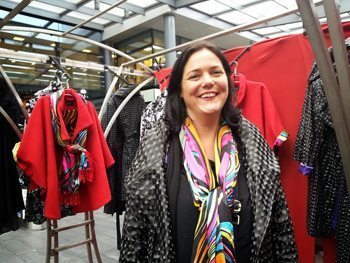
“Great, that’s a really good one!” Rosemary is bending down to photograph a red splash of paint with a figure stenciled into the middle of it.
She’s on the hunt for street art, and here in the East End of London, the would-be Banksys have been out with their spray cans so she’s spoilt for choice.
But trend-setting graffiti is only one of the area’s attractions. Rosemary and her two friends – a trio of snappily dressed forty somethings – have crossed the Atlantic and headed to East London for the shopping.
“We aren’t really the Chanel type,” she grins. “We are interested in the forward edge of retail. This is the place where you get all the little shops – we aren’t looking for global brands, you get all that in New York.”
It’s true, but may be short-lived. With chain stores encroaching on one side and big banks on the other, gentrification is making inroads into an area that used to be a by-word for edginess. For now, the East End still bears that veneer of grit and grime which betrays where it’s come from and keeps it cool.
Eastern Inventiveness

In one of the world’s most fashion-conscious cities, it is the eastern part of town which provides much of the inventiveness and creative drive. This is where the worlds of art and fashion collide.
Around the three hubs of Hoxton, Spitalfields, and Shoreditch, you’ll discover streets crackling with hipster energy, crowds of Boho young things breathing new life into ancient buildings.
Coffee shops, independent clothing stores, little galleries, and eclectic markets are all jammed together, and at night they give way to a galaxy of trendsetting bars and clubs.
Nude Espresso
My day ‘up East’ began with a good, fierce latte behind the red frontage of Nude Espresso, a tiny corridor of a café packed with graphic types wearing chunky specs and tapping Apple Macs. (Coffee and tangy mixed berry scone with butter £5.30) From there to the Whitechapel Art Gallery, to view the Sarah Lucas show. Lucas is a Young British Artist (YBA), part of the ground-breaking group that produced Damien Hirst.
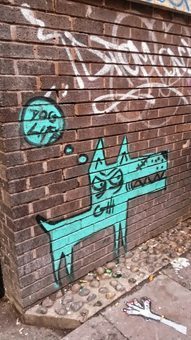
Her work is lusty and visceral, featuring massive pictures of herself, fried eggs arranged to suggest breasts, kitchen tables, an orange neon coffin, and – a massive phallus made of plaster.
Strange how people coming into a gallery seem to avoid looking directly at the thing in the center of the floor when it’s a giant male appendage.
The more serious point is that Lucas is a significant contemporary artist, and this is an important gallery in the firmament of the London art scene.
It’s been here for a hundred years, but its transformation from an institution intended to educate the working class is intimately tied in with the development of the East End as one of the densest concentrations of working artists in Europe.
Originally this was one of the poorest and roughest parts of town, home to generations of immigrants – Huguenots, Jews, Bengalis, and now Somalis. In the Seventies, the contraction of the docks and the closure of factories left the property empty, and therefore affordable by struggling artists who were also drawn in by the distinctive aesthetic of its bleak landscape.
Gilbert & George

Back then, Gilbert & George made their home in Fournier Street, a road of perfectly preserved Huguenot houses in Spitalfields, and have never left. Tracey Emin, another flourishing YBA, lives and works there too.
Where artists lead others follow, and by the time film star Keira Knightley bought a house here in 2012 the price tag had rocketed to £2.5 million.
The rapid evolution from tatty to trendy was galvanized by one other big change – the redevelopment of Spitalfields market. It’s a brisk ten-minute walk up the Commercial Road from Whitechapel to this cozy patchwork of stalls fringed with eateries under architect Norman Foster’s glass and steel roof.
Wasteland until 1987
Until 1987 it was a working fruit and veg market in a wasteland still defined by its poverty. After dark, the barrow boys would warm themselves by lighting bonfires from discarded wooden palates, while all-night pubs served steaming plates of pork cheek.
Market manager Ray Dervin remembers those days and has seen through all the changes since the site was remade. A small stocky man with a bristling white mustache, he owns the aisles and patrols them like the mayor of a small town greeting each of the stall-holders by their first names.
The new Spitalfields Market started trading on Sundays only, specializing in organics when they were a rarity. Now it is open every day of the week, with an emphasis on clothing plus an eclectic choice of other wares, from second-hand CDs to greetings cards and dog paraphernalia to hand-made candles. Saturday is a premium designer-only market.
Lizzie Nolan has been here for five years, selling her 1950s inspired dress coats. “It’s about keeping things individual,” she says, describing Spitalfields as one small bastion against the ongoing ‘Zarafication’ of the world. Here a woman ‘of a certain age’ can get a well-made garment that’s crafted and different for anything from £90 to £149.
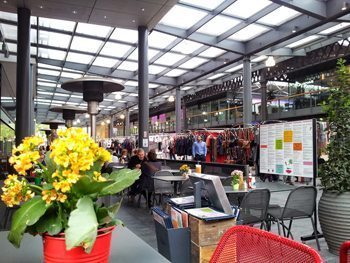
There’s no doubt that this bustling and the well-groomed market has helped to redefine the whole area.
But Ray Devlin thinks the big banks spreading their tentacles eastwards out of the City into Broadgate have also had an impact, bringing the inevitable string of Starbucks and upmarket chain boutiques.
Can they really be blamed for the fact that Urban Outfitters and Nando’s now stare balefully at Spitalfields from across the Commercial Road?
Fashion Moves North
It is said that the frontier of fashion has moved north to Redchurch Street, which may be true. But meanwhile, a select coterie of small entrepreneurs is mounting a defense. In Hanbury Street, Justin Deakin is purveying his handsome handmade shoes, traditional with a twist.
I walk out of Spitalfields market on its south side through the original façade now gloriously restored, to find myself in Brushfield Street. Here, beneath the looming spire of Hawksmoor’s eighteenth-century Spitalfields Church, novelist Jeanette Winterson has recreated a romantic take on a period grocery store at Verde.
Outside, vegetables and baskets hang from the awnings. Inside the shelves are piled to the eaves with organic rhubarb cordial, greengage marmalade, and minimalist Belgian chocolates that look like jewels and cost as much.

As if it wasn’t a tight enough squeeze already, seven high-backed stools are crammed up against butcher’s block tables.
My second latte of the day is smooth and strong, and given extra tang by the confidences, I’m exposed to by virtue of the intimate seating. A pony-tailed artist at my elbow is angsting to his agent about the asking price of his canvases.
Apparently other contributors to his group show have been outraged at the tag of £1,000 on his work, but they are selling like hotcakes anyway. Is it his fault? He shrugs.
I busy myself with my sandwich, a melting combination of marinated aubergine and artichoke topped by pungent parmesan shavings on the softest, freshest granary bread. At the same time, I’m hoovering up the painter’s compelling mix of arrogance and defensiveness. I suck the olive oil from my fingers greedily but as discreetly as I can, hungry for more.
Nude Espresso
26 Hanbury St London E1 6QR
07804 223590
website
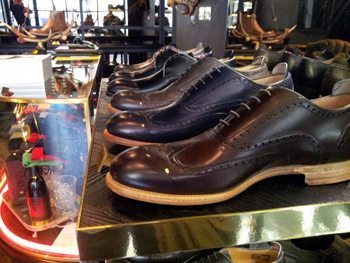
Whitechapel Gallery
77-82 Whitechapel High St London E1 7QX
020 7522 7888
website
Spitalfields Market
Brushfield Street
Spitalfields
London E1 6AA
website
Justin Deakin handmade shoes
22 Hanbury Street
London E1 6QR
website
Find cool lodging in East London
website
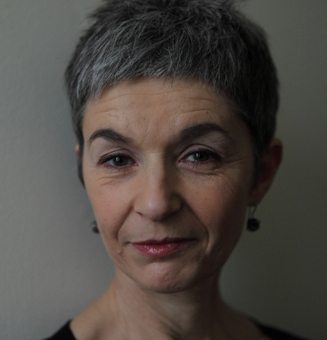
Gaby Koppel is a London-based freelance journalist and television producer whose print work has appeared in a wide range of national titles including The Guardian, The Daily Mail and The Sunday Times. She is a graduate of the MA program in Creative Writing (Novels) at City University, where her work in progress won the Christopher Little Literary Agency Award.
- These 9 U.S. National Parks Require Reservations in 2024 - April 17, 2024
- Take a Hike in Olympic National Park - April 17, 2024
- The Wild Mississippi: 2340 Miles Across Ten States - April 8, 2024


